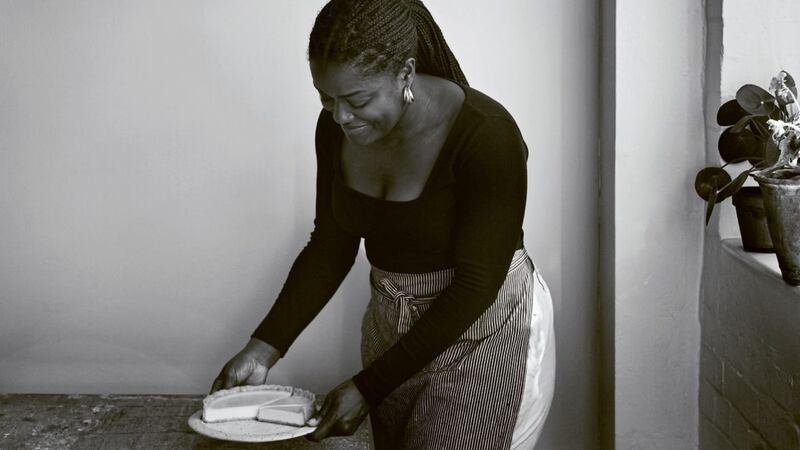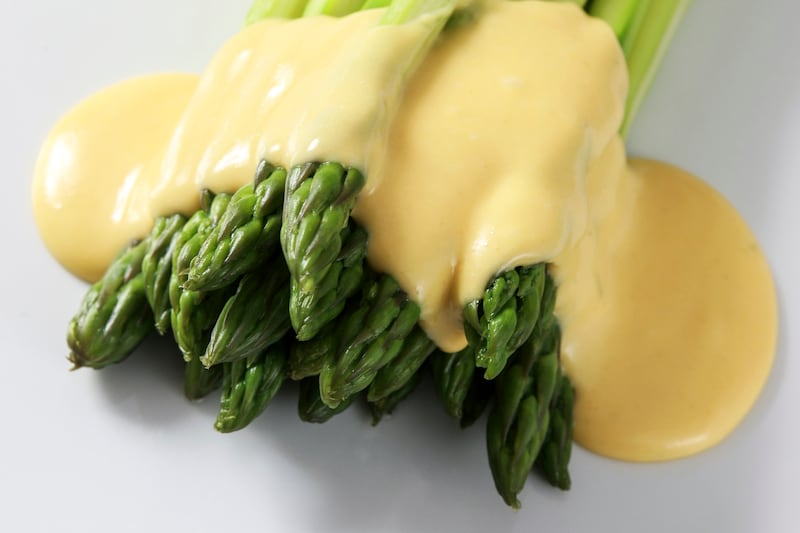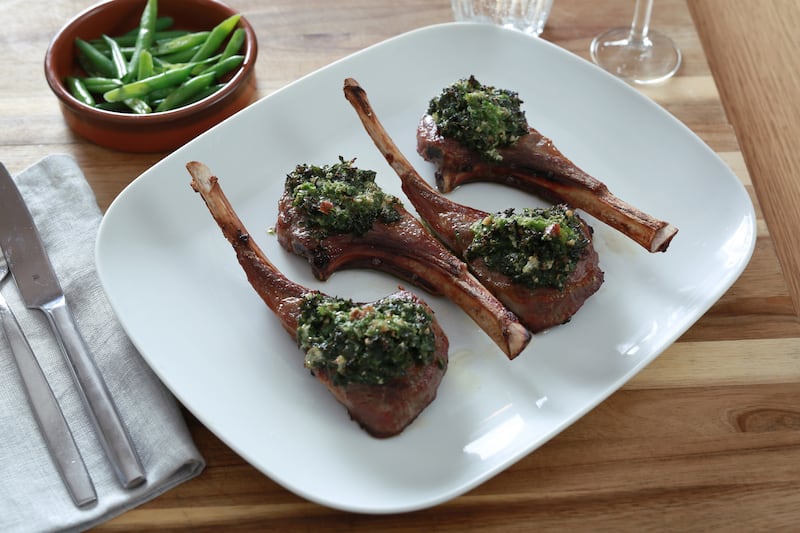BENJAMINA Ebuehi wants to reclaim the beauty of beige food.
While it doesn’t always have the best reputation for being particularly nutritious or tasty, Ebuehi still loves it – and has dedicated a whole chapter in her new cookbook to the ‘Best of beige’.
“You don’t need to add colour. It’s honestly a beautiful colour in its own right,” she says passionately.
Perhaps it’s also partly because Ebuehi (29), wrote her latest cookbook, A Good Day To Bake, in lockdown. This means she was craving “comfort food” more than normal, and it’s these wholesome, comforting and – yes – beige bakes that permeate the book.
Fans of The Great British Bake Off will remember Ebuehi as a talented baker who made it to the quarter-finals in 2016, known for her bold flavours and wide smile. She’s still very much got the same sunny disposition, and laughs frequently – even though the water in her house had unexpectedly been shut off the day we speak. “Everyone’s at home – but yeah, turn the water off, great,” she says, giggling.
In the new book, Ebuehi doesn’t just want to change people’s minds about beige food though. She also wants to convince wannabe bakers to try new and interesting flavour combinations, and ingredients they might not have thought about before.
“If people are comfortable with carrot cake, then I don’t think parsnip is that far away,” she reasons.
“We shouldn’t feel like we have to limit ourselves to particular ingredients, or particular recipes. Especially within savoury cooking, there is so much variety and so many combinations – and a lot of them can work really, really well within baking. So it’s about opening that creative side, and giving it a go.”
Unexpected ingredients pop up throughout Ebuehi’s sweet bakes – from sage doughnuts to fennel and peach cobbler. She admits a lot of her inspirations come from savoury recipes – particularly when eating out.
“I’ve always had a palate for things that are just a little bit different,” she adds.
“I do love the classics, the things you don’t really want to touch and tamper with. But I think they’re so much more interesting when you can add something a little unexpected – and when you give something to someone to try, and they’re not expecting a particular flavour, but it works. I’ve always enjoyed giving people something a little bit unexpected.”
Although not a sweet dish, the plantain and fennel quiche is certainly a surprising combination – and it’s particularly close to Ebuehi’s heart, growing up in a Nigerian family in London. “I love that one, because plantain is such a staple in our household,” she says.
“We eat it all the time, so to be able to include it in the book was really special. And in a quiche – I mean, my parents, my family have never had it in a quiche, so it was really fun to play around with that. And they really liked it, my cousins loved it.
“Showcasing ingredients we’ve grown up with, but in a different way, has been really cool.”
Ebuehi’s often asked where she learned to bake, but she admits it wasn’t from her family. While she says her mother is “really, really good” at cooking, “she would not bake at all”. Instead, Ebuehi’s love of baking was organic, and her own adventure.
“I started quite young, maybe nine or 10,” she says.
“But it was very much fairy cakes, basic biscuits – that sort of thing.” When her mum got her a kids’ cookbook, she started working her way through that: “And I’ve been doing it ever since.”
Ebuehi got serious about baking when she went to the University of Leicester, studying economics – and then she got the call-up for Bake Off in 2016.
A lot has changed in the six years since she appeared on the show, and she’s now onto her second cookbook. “I’m definitely more confident in the flavours I like, the way I style my food – keeping it really simple and pared back. I’m more assured of my style and my voice in my recipes than I was back then,” she reflects.
“Back then, I was very young and had lots of ideas, but didn’t really know how to execute them. I’m definitely more confident in the way I speak now.”
One thing that hasn’t changed? Ebuehi’s penchant for carrot cake. She calls it her “first love”, explaining it was “one of the first cakes I made that I really, really, really loved and tweaked and made my own recipe for – so that’s still one I make quite often today”.
A Good Day To Bake: Simple Baking Recipes For Every Mood by Benjamina Ebuehi is published by Quadrille on March 17, priced £22. Photography by Laura Edwards. Below are three recipes for you to try at home...
BANANA, TAHINI AND RUM CAKE
(Serves 8-10)
For the cake:
2 eggs
100g light brown sugar
100g dark brown sugar
75g tahini
300g bananas
3tbsp dark rum
150g plain flour
100g wholemeal rye flour
2tsp baking powder
¼tsp bicarbonate of soda
½tsp ground cinnamon
Pinch of salt
Walnuts, to decorate
For the glaze:
60g icing sugar
½tbsp dark rum
½tsp tahini
1tsp vanilla bean paste
Method:
Preheat the oven to 180°C. Grease and line the base of a 20 centimetre springform or loose-bottomed cake pan. In a large bowl, whisk the eggs and sugars together for a minute or so until combined and just a little bit paler. Mix in the tahini. In a separate bowl, mash the bananas with the rum. Add the bananas to your egg mixture and stir to combine. Add both the flours, the baking powder, bicarbonate of soda, cinnamon and salt. Stir until just combined. Pour the batter into the prepared cake pan and bake for about 40–45 minutes or until a skewer inserted into the middle of the cake comes out clean. Leave to cool a little in the pan while you make the glaze. To make the glaze, mix together all of the glaze ingredients until smooth and you have a pourable consistency. If it is too thick, add a teaspoon of water at a time to loosen. Pour the glaze over the warm cake and let it set for 10 minutes before turning the cake out onto a serving plate. Top with walnuts to decorate and let it cool completely before serving.
PLANTAIN AND FENNEL QUICHE
(Serves 6)
For the pastry:
200g plain flour, plus extra for dusting
120g unsalted butter
½tsp fine sea salt
1 egg yolk
2–4tbsp cold water
For the filling:
2 eggs
275ml double cream
1 large ripe plantain
1 red onion
1 fennel bulb
2tbsp olive oil
1 garlic clove, minced/grated
2 sprigs of fresh thyme, leaves picked, plus extra to garnish
50g Gruyere cheese, grated
Sea salt and freshly ground black pepper
Method:
Start by making the pastry. Pulse the flour, butter and salt in a food processor until fine. Alternatively, rub the butter into the flour with your fingertips if making by hand. Add the egg yolk and two tablespoons of the cold water. Pulse or stir until the pastry starts to clump together. Add more water, a tablespoon at a time, if the pastry is too dry. Turn the dough out onto a clean surface and give it a couple of quick, light kneads to bring it together. Flatten it into a thick disc, wrap in plastic wrap and chill in the refrigerator for one to two hours, or until firm. Once chilled, roll the dough out on a lightly floured surface to about five millimetres thick. Get six 10cm round tart pans ready– there’s no need to grease them. Cut out six pastry circles slightly larger than your tart pans and press them into the pans, leaving a little pastry overhanging the sides. You may need to re-roll the pastry to get all six circles. Prick the bases with a fork, and line the cases with pieces of scrunched-up baking paper. Fill with baking beans or uncooked rice, then chill the pastry for 15 minutes. Meanwhile, preheat the oven to 190°C. Bake the tart cases for 20 minutes before carefully removing the baking beans and paper. Place them back in the oven and bake for a further seven to 10 minutes, or until the pastry is golden. Remove from the oven and set aside to cool. Meanwhile, prepare the filling. Whisk together the eggs and cream along with a big pinch of salt. Set aside. Peel and slice the plantain into rounds five millimetres thick. Finely chop the onion. Trim off the fennel fronds, cut the fennel bulb in half and then thinly slice. Heat the olive oil in a frying pan over a medium heat, add the plantain and fry, turning a few times until golden brown. Remove from the pan and set aside. Using the same pan, fry the onions and fennel for eight to 10 minutes until the fennel is soft and translucent. Stir in the grated garlic and thyme leaves and fry for another minute. Season with salt and pepper before removing from the heat.
When you’re ready to assemble, sprinkle a little of the grated Gruyere on the base of the pastry cases. Split the fennel and onion mixture evenly among the tarts and top with a few slices of the fried plantain. Add a little more cheese on top, along with some more thyme. Pour the egg and cream mixture into the cases, filling to the top. Bake the quiches for 18–22 minutes until the eggs are set with a little wobble in the middle. Remove from the oven and let cool for 20 minutes before serving a little warm.
PARSNIP, ORANGE AND GINGER LOAF
(Serves 8-10)
For the parsnip crisps:
1 parsnip
1tsp olive oil
2tsp maple syrup or honey
Pinch of salt
For the cake:
160ml sunflower or vegetable oil, plus extra for greasing
160g light brown sugar
Zest of 1 orange
2 eggs
200g parsnips, grated
210g plain flour
1½tsp baking powder
½tsp bicarbonate of soda
2tsp ground ginger
¼tsp ground cloves
60g walnuts, roughly chopped, plus extra to decorate
For the glaze:
90g icing sugar
Juice of ½ orange
Method:
Preheat the oven to 180°C. Line a baking sheet with baking paper and grease and line a 900-gram loaf pan. Start by making the parsnip crisps. Use a mandoline or potato peeler to thinly slice the parsnip. Place the peelings on the baking sheet and drizzle with the oil, maple syrup or honey and pinch of salt. Toss them with your hands to make sure all the pieces are coated and lay them out evenly so they don’t overlap. Bake for 15–20 minutes, turning once halfway through. Keep a close eye on them, as they can catch quite easily. Remove from the oven and set aside to cool. For the cake, mix together the oil, sugar and orange zest in a bowl. Beat in the eggs and stir until smooth, then carefully mix in the grated parsnips. In a separate bowl, mix together the flour, baking powder, bicarbonate of soda, ground ginger and cloves. Add to the wet ingredients and mix gently until just combined. Now stir in the chopped walnuts. Pour the batter into the loaf pan and bake for 45–50 minutes or until a skewer inserted into the middle of the cake comes out clean. Remove from the oven and leave to cool in the pan for 15 minutes before turning out onto a wire rack to cool completely. To make the glaze, mix the icing sugar and orange juice in a small bowl until smooth. You want it to be a thick but pourable consistency. Add a little more icing sugar if it’s too thin or a bit more orange juice if it’s too thick. Once the cake is completely cool, pour the glaze on top, letting it drip down the sides. Top with the parsnip crisps and extra chopped walnuts before serving.








